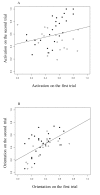Beer consumption increases human attractiveness to malaria mosquitoes
- PMID: 20209056
- PMCID: PMC2832015
- DOI: 10.1371/journal.pone.0009546
Beer consumption increases human attractiveness to malaria mosquitoes
Abstract
Background: Malaria and alcohol consumption both represent major public health problems. Alcohol consumption is rising in developing countries and, as efforts to manage malaria are expanded, understanding the links between malaria and alcohol consumption becomes crucial. Our aim was to ascertain the effect of beer consumption on human attractiveness to malaria mosquitoes in semi field conditions in Burkina Faso.
Methodology/principal findings: We used a Y tube-olfactometer designed to take advantage of the whole body odour (breath and skin emanations) as a stimulus to gauge human attractiveness to Anopheles gambiae (the primary African malaria vector) before and after volunteers consumed either beer (n = 25 volunteers and a total of 2500 mosquitoes tested) or water (n = 18 volunteers and a total of 1800 mosquitoes). Water consumption had no effect on human attractiveness to An. gambiae mosquitoes, but beer consumption increased volunteer attractiveness. Body odours of volunteers who consumed beer increased mosquito activation (proportion of mosquitoes engaging in take-off and up-wind flight) and orientation (proportion of mosquitoes flying towards volunteers' odours). The level of exhaled carbon dioxide and body temperature had no effect on human attractiveness to mosquitoes. Despite individual volunteer variation, beer consumption consistently increased attractiveness to mosquitoes.
Conclusions/significance: These results suggest that beer consumption is a risk factor for malaria and needs to be integrated into public health policies for the design of control measures.
Conflict of interest statement
Figures




Similar articles
-
Variability in human attractiveness to mosquitoes.Curr Res Parasitol Vector Borne Dis. 2021 Nov 2;1:100058. doi: 10.1016/j.crpvbd.2021.100058. eCollection 2021. Curr Res Parasitol Vector Borne Dis. 2021. PMID: 35284885 Free PMC article. Review.
-
Evolutionary lability of odour-mediated host preference by the malaria vector Anopheles gambiae.Trop Med Int Health. 2009 Feb;14(2):228-36. doi: 10.1111/j.1365-3156.2009.02206.x. Epub 2009 Jan 28. Trop Med Int Health. 2009. PMID: 19187525
-
Interindividual variation in the attractiveness of human odours to the malaria mosquito Anopheles gambiae s. s.Med Vet Entomol. 2006 Sep;20(3):280-7. doi: 10.1111/j.1365-2915.2006.00627.x. Med Vet Entomol. 2006. PMID: 17044878
-
Host-specific cues cause differential attractiveness of Kenyan men to the African malaria vector Anopheles gambiae.Malar J. 2002 Dec 6;1:17. doi: 10.1186/1475-2875-1-17. Epub 2002 Dec 6. Malar J. 2002. PMID: 12513703 Free PMC article.
-
Odor-mediated behavior of Afrotropical malaria mosquitoes.Annu Rev Entomol. 1999;44:131-57. doi: 10.1146/annurev.ento.44.1.131. Annu Rev Entomol. 1999. PMID: 9990718 Review.
Cited by
-
Seasonal climate effects anemotaxis in newly emerged adult Anopheles gambiae Giles in Mali, West Africa.PLoS One. 2011;6(11):e26910. doi: 10.1371/journal.pone.0026910. Epub 2011 Nov 16. PLoS One. 2011. PMID: 22114663 Free PMC article.
-
Olfaction in Anopheles mosquitoes.Chem Senses. 2021 Jan 1;46:bjab021. doi: 10.1093/chemse/bjab021. Chem Senses. 2021. PMID: 33885760 Free PMC article. Review.
-
Variability in human attractiveness to mosquitoes.Curr Res Parasitol Vector Borne Dis. 2021 Nov 2;1:100058. doi: 10.1016/j.crpvbd.2021.100058. eCollection 2021. Curr Res Parasitol Vector Borne Dis. 2021. PMID: 35284885 Free PMC article. Review.
-
Taking a bite out of nutrition and arbovirus infection.PLoS Negl Trop Dis. 2018 Mar 29;12(3):e0006247. doi: 10.1371/journal.pntd.0006247. eCollection 2018 Mar. PLoS Negl Trop Dis. 2018. PMID: 29596427 Free PMC article. Review.
-
An online survey of personal mosquito-repellent strategies.PeerJ. 2018 Jul 3;6:e5151. doi: 10.7717/peerj.5151. eCollection 2018. PeerJ. 2018. PMID: 30002979 Free PMC article.
References
-
- Feachem R, Sabot O. A new global malaria eradication strategy. Lancet. 2008;371:1633–5. - PubMed
-
- World Health Organization. (2008) World malaria report. WHO, Geneva.
-
- Ross R. The prevention of malaria. 2nd edition. 1911. Murrey, London.
-
- Macdonald G. The epidemiology and control of malaria. 1957. Oxford University Press.
-
- Dye C. The analysis of parasite transmission by blood-sucking insects. Annu Rev Entomol. 1992;37:1–19. - PubMed
Publication types
MeSH terms
Substances
LinkOut - more resources
Full Text Sources

